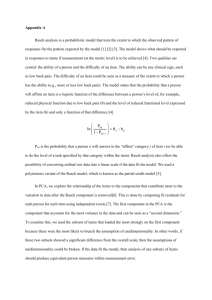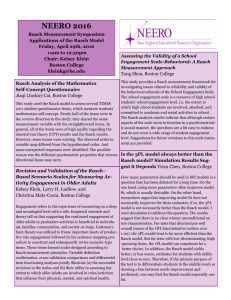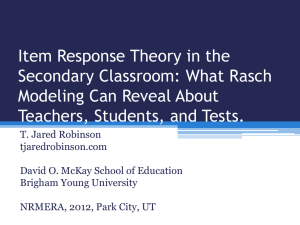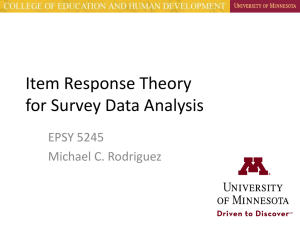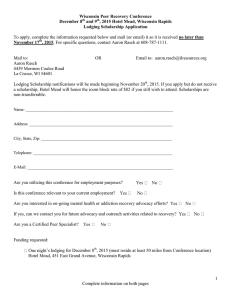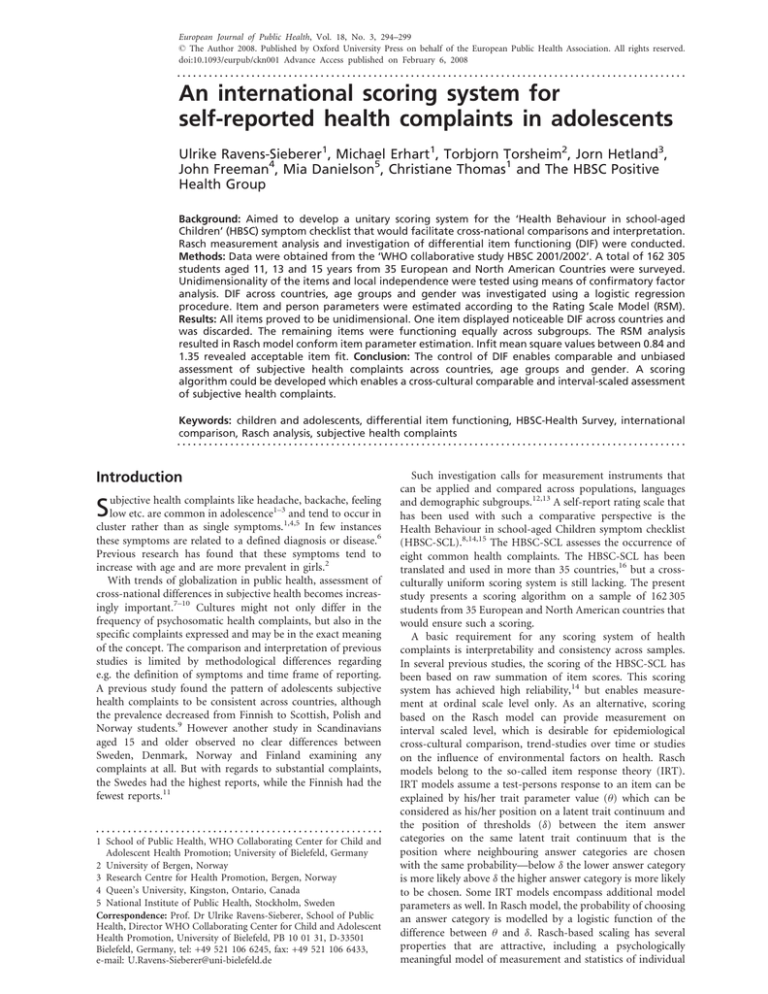
European Journal of Public Health, Vol. 18, No. 3, 294–299
ß The Author 2008. Published by Oxford University Press on behalf of the European Public Health Association. All rights reserved.
doi:10.1093/eurpub/ckn001 Advance Access published on February 6, 2008
................................................................................................
An international scoring system for
self-reported health complaints in adolescents
Ulrike Ravens-Sieberer1, Michael Erhart1, Torbjorn Torsheim2, Jorn Hetland3,
John Freeman4, Mia Danielson5, Christiane Thomas1 and The HBSC Positive
Health Group
Background: Aimed to develop a unitary scoring system for the ‘Health Behaviour in school-aged
Children’ (HBSC) symptom checklist that would facilitate cross-national comparisons and interpretation.
Rasch measurement analysis and investigation of differential item functioning (DIF) were conducted.
Methods: Data were obtained from the ‘WHO collaborative study HBSC 2001/2002’. A total of 162 305
students aged 11, 13 and 15 years from 35 European and North American Countries were surveyed.
Unidimensionality of the items and local independence were tested using means of confirmatory factor
analysis. DIF across countries, age groups and gender was investigated using a logistic regression
procedure. Item and person parameters were estimated according to the Rating Scale Model (RSM).
Results: All items proved to be unidimensional. One item displayed noticeable DIF across countries and
was discarded. The remaining items were functioning equally across subgroups. The RSM analysis
resulted in Rasch model conform item parameter estimation. Infit mean square values between 0.84 and
1.35 revealed acceptable item fit. Conclusion: The control of DIF enables comparable and unbiased
assessment of subjective health complaints across countries, age groups and gender. A scoring
algorithm could be developed which enables a cross-cultural comparable and interval-scaled assessment
of subjective health complaints.
Keywords: children and adolescents, differential item functioning, HBSC-Health Survey, international
comparison, Rasch analysis, subjective health complaints
................................................................................................
Introduction
ubjective health complaints like headache, backache, feeling
1–3
and tend to occur in
cluster rather than as single symptoms.1,4,5 In few instances
these symptoms are related to a defined diagnosis or disease.6
Previous research has found that these symptoms tend to
increase with age and are more prevalent in girls.2
With trends of globalization in public health, assessment of
cross-national differences in subjective health becomes increasingly important.7–10 Cultures might not only differ in the
frequency of psychosomatic health complaints, but also in the
specific complaints expressed and may be in the exact meaning
of the concept. The comparison and interpretation of previous
studies is limited by methodological differences regarding
e.g. the definition of symptoms and time frame of reporting.
A previous study found the pattern of adolescents subjective
health complaints to be consistent across countries, although
the prevalence decreased from Finnish to Scottish, Polish and
Norway students.9 However another study in Scandinavians
aged 15 and older observed no clear differences between
Sweden, Denmark, Norway and Finland examining any
complaints at all. But with regards to substantial complaints,
the Swedes had the highest reports, while the Finnish had the
fewest reports.11
Slow etc. are common in adolescence
1 School of Public Health, WHO Collaborating Center for Child and
Adolescent Health Promotion; University of Bielefeld, Germany
2 University of Bergen, Norway
3 Research Centre for Health Promotion, Bergen, Norway
4 Queen’s University, Kingston, Ontario, Canada
5 National Institute of Public Health, Stockholm, Sweden
Correspondence: Prof. Dr Ulrike Ravens-Sieberer, School of Public
Health, Director WHO Collaborating Center for Child and Adolescent
Health Promotion, University of Bielefeld, PB 10 01 31, D-33501
Bielefeld, Germany, tel: +49 521 106 6245, fax: +49 521 106 6433,
e-mail: U.Ravens-Sieberer@uni-bielefeld.de
Such investigation calls for measurement instruments that
can be applied and compared across populations, languages
and demographic subgroups.12,13 A self-report rating scale that
has been used with such a comparative perspective is the
Health Behaviour in school-aged Children symptom checklist
(HBSC-SCL).8,14,15 The HBSC-SCL assesses the occurrence of
eight common health complaints. The HBSC-SCL has been
translated and used in more than 35 countries,16 but a crossculturally uniform scoring system is still lacking. The present
study presents a scoring algorithm on a sample of 162 305
students from 35 European and North American countries that
would ensure such a scoring.
A basic requirement for any scoring system of health
complaints is interpretability and consistency across samples.
In several previous studies, the scoring of the HBSC-SCL has
been based on raw summation of item scores. This scoring
system has achieved high reliability,14 but enables measurement at ordinal scale level only. As an alternative, scoring
based on the Rasch model can provide measurement on
interval scaled level, which is desirable for epidemiological
cross-cultural comparison, trend-studies over time or studies
on the influence of environmental factors on health. Rasch
models belong to the so-called item response theory (IRT).
IRT models assume a test-persons response to an item can be
explained by his/her trait parameter value () which can be
considered as his/her position on a latent trait continuum and
the position of thresholds () between the item answer
categories on the same latent trait continuum that is the
position where neighbouring answer categories are chosen
with the same probability—below the lower answer category
is more likely above the higher answer category is more likely
to be chosen. Some IRT models encompass additional model
parameters as well. In Rasch model, the probability of choosing
an answer category is modelled by a logistic function of the
difference between and . Rasch-based scaling has several
properties that are attractive, including a psychologically
meaningful model of measurement and statistics of individual
Scoring self-reported health complaints
measurement error. Unidimensional constructs can be identified and biased or weak indicators can be detected. If the Rasch
model fits the data well the sum of the item-scores represents
a sufficient statistic for the response to all items. Examining the
single item scores would then not add any crucial psychometric information to the measurement.17,18,19 Applying the
HBSC-SCL as a short screening instrument requires setting up
thresholds for a noticeable outcome. Rasch-based scaling
provides the possibility of linking scores with the meaningful
item-content17 thus helping to define cut-off points.
For a scale to be scored according to the Rasch model, the
covariation between the items of the scale has to satisfy the
relatively stringent assumptions of local independence and
unidimensionality (the item score should not be related to any
other item score expect through the contribution of both to
the scale score).17,18 Two previous studies of the dimensionality of the HBSC-SCL with confirmatory factor analysis (CFA)
revealed adequate fit for a one-factor model. A correlated twofactor model (physical and psychological) was clearly superior.14,15 However, the correlation between these two factors
was extremely high (0.80–0.82). Thus, in the present study, our
expectation was that the HBSC-SCL would show sufficient
unidimensionality.
Multidimensionality may result in poor Rasch item fit
statistics.20 A way to prevent this is to apply explicit tests of
unidimensionality, which might be more sensitive and specific
than the CFA analyses14,15 which e.g. can fail in the presence of
differing item difficulties.18,21,22
Rasch modelling of the HBSC symptom checklist was
applied in a recent study.23 The partial credit model (PCM)
was examined in a sample of Swedish adolescents, using the
HBSC-SCL. Reversed thresholds—that is at least one answer
category is at no position of the latent trait most likely to be
chosen (which does not necessarily mean that the answer
categories operate in a reversed order)—were found for three
items. As a solution, the authors suggested discarding the three
mentioned items. The five remaining items showed item
characteristic curves that were consistent with the PCM.
This study23 highlights some of the challenges in applying
the Rasch model to existing rating instruments, including the
problem of how to deal with violations of the Rasch model
assumptions. When reversed thresholds are present, one
alternative to discarding items could be to collapse response
categories.18,24 A problem with collapsing response categories
is the potential loss of psychometric information. A second
feasible alternative would be to force the threshold estimates
being in the right order and to test whether response patterns
are consistent with such variants of the Rasch model.
For scales with a uniform set of response categories across
items, such as the HBSC-SCL, the Rasch Rating scale model
(RSM)25 may be a good alternative to the PCM. The
assumption made in the RSM is that items differ in their
location on the latent trait, but that the distance between
thresholds and the order of category thresholds are the same
across items25
The aims of this study were to investigate:
(1) If the actual response behaviour of the tested adolescents
on the HBSC-items can be reasonably explained by the
assumption of ordered thresholds and a unidimensional
latent trait continuum.
(2) If the items are functioning in the same way across
countries, age groups and gender.
(3) If a new scoring algorithm could be established.
(4) The results of the new scoring algorithm in terms of
demographic differences and the association with health
status.
(5) The results of the new scoring in terms of cross-national
variation and consistency.
295
Methods
Sample and data collection
Data were obtained from the large cross-national WHO collaborative study ‘Health Behaviour in School-aged Children’
2001/2002.26 A total of 162 305 students from 35 countries
and regions participated, 51.7% were females, 33.6% were aged
10–12, 34.6% were aged 12–14, 31.8% were aged 14–16.
The sample was selected through a complex multistage
sampling procedure. The primary sampling unit was schoolclass, with self- selection of students. More detailed information about the sample and the sampling frame can be obtained
elsewhere.26,27 The multistage sampling makes it difficult to
compute a single response rate. The available documentation
suggest that for a majority of countries, the response rate at the
level of school was above 80% with additional dropout at the
student-level ranging from 2.4 to 26.0%. Combining all
available information the weighted response rate was 75%
(authors calculation).
Instrument and variables
The eight items of the HBSC-Symptom checklist ask about
how often in the last 6 months the children and adolescents
have suffered from the following complaints: headache,
stomach ache, backache, feeling low, irritable or bad tempered,
feeling nervous, sleeping difficulties, dizziness. The children
and adolescents can respond to these questions by choosing
one of the following five answer categories: ‘rarely or never’,
‘about every month’, ‘about every week’, ‘more than once a
week’ and ‘about every day’.27 Additional information used for
the analyses included the age, gender and self-reported general
health status of the respondents.
Statistical analysis
Subjects with missing values in any variable (2.9% of all cases)
were omitted from the analysis. A confirmatory factor-analysis
was computed (Mplus) by specifying a one-factor-structural
equation model across all items using polychoric correlations.
Items with loading above 0.4 remained in the item pool. To
assess local dependence, the common factor was partialized
out of the items and the item residuals were correlated with
each other.28 If the residuals of two or more items correlated
above 0.2 with each other, one or more of the involved items
were eliminated.29
Students with the same level of trait should respond
similarly to an item, regardless of their culture, age or
gender. Differential item functioning (DIF) occurs when
people at the same level of trait but from e.g. different
countries respond differently. To examine DIF, we used the
logistic regression approach described by Zumbo:13 Every item
serves as the dependent variable in hierarchical ordinal
regression models. The goodness of fit of a logistic regression
model with the total score being the only covariate was
compared with the goodness of fit of a model where the total
score, the group and the group total score interaction were
the covariates. The significance of the 2-changes, as well as the
change in the Nagelkerke pseudo-R2, was investigated. While
the first value tells about significant uniform (different
locations on the latent trait), non-uniform (different slopes)
and absolute DIF, the second statistic gives an impression
about the effect size of the DIF. A pseudo-R2 change of 0.035
has been suggested as a criterion for practically meaningful
DIF.30 We thus set the threshold for a tolerable DIF effect to an
R2 change of 0.035 but acknowledged that other authors
proposed quite less restrictive thresholds of 0.07.13 The
analyses were carried out using the PLUM procedure of SPSS.
296
European Journal of Public Health
Table 1 Differential item functioning across countries, age and gender – identified with logistic regression procedure
DIF countrya
DIF ageb
DIF genderc
Item
R2-changed
Pd
R2-changec
Pd
R2-change
Pd
Headache
Stomach ache
Backache
Feeling low
Irritable bad tempered
Nervous
Sleeping difficulties
Dizziness
0.013
0.019
0.014
0.036
0.023
0.037
0.045
0.015
<0.001
<0.001
<0.001
<0.001
<0.001
<0.001
<0.001
<0.001
<0.001
0.004
0.012
0.003
0.002
0.001
0.003
<0.001
<0.001
<0.001
<0.001
<0.001
<0.001
<0.001
<0.001
<0.001
0.003
0.014
0.003
0.001
0.002
0.001
0.002
0.004
<0.001
<0.001
<0.001
<0.001
<0.001
<0.001
<0.001
<0.001
a:
b:
c:
d:
Random 5% of the overall sample versus non-selected single country-samples
15-year olds versus 11-year olds and versus 13-year olds
Girls versus boys
Transgression probability of the difference in the –2loglikelihood 2-value; and Difference in the Nagelkerke R2-value
between Ordinal Logistic Regression ‘base’ model (item regressed on total score) and ‘uniform/non-uniform DIF’ model (item
regressed on total score, group, total score group). The group is defined by country, age or gender
Table 2 Item fit and parameter estimation according to the rating scale model (extra-conditional joint maximum likelihood
estimation)
Headache
Stomach ache
Backache
Feeling low
Irritable-bad temper
Nervous
Dizziness
a:
b:
c:
d:
Infit msqa
Locationb,c
Step1b,d
(SE)
Step2b,d
(SE)
Step3b,d
(SE)
Step4b,d
(SE)
1.02
0.97
1.35
0.92
0.84
0.96
1.24
48.99
51.85
53.49
49.12
45.08
46.00
55.47
44.1
47.0
48.6
44.3
40.2
41.1
50.6
(0.02)
(0.02)
(0.02)
(0.02)
(0.02)
(0.02)
(0.02)
47.8
50.7
52.3
48
43.9
44.9
54.3
(0.03)
(0.03)
(0.03)
(0.03)
(0.03)
(0.03)
(0.03)
48.5
51.4
53.0
48.7
44.6
45.5
55.0
(0.03)
(0.03)
(0.03)
(0.03)
(0.03)
(0.03)
(0.03)
55.5
58.3
59.9
55.6
51.5
52.5
61.9
(0.05)
(0.05)
(0.05)
(0.05)
(0.05)
(0.05)
(0.05)
Infit mean square values between 0.7 and 1.3 indicate good fit to the Rasch model
Item-parameter-based metric (sample mean = 38.5; SD = 12.1)
Mean of step-parameter
Steps = threshold parameter (location on latent trait continuum were neighbouring answer categories are chosen with equal
probability)
The estimation of the Rasch RSM parameters was done
using the WINSTEPS program joint maximum likelihood
procedure.31 In this procedure, the ‘person-parameter’ of every
single respondent is estimated simultaneously with the item
parameter. The disadvantages of this procedure are that it may
lead to inconsistent estimations especially in large samples and
short scales of <10 items.18,19 To correct for this potential bias
we used the extra-conditional method (XCON, XMLE).32
In the present study, data fit was indicated by the infit mean
square statistic, which is based on the residuals between the
empirical and the theoretical expected item scores.18 In line
with conventional criteria,24 a well fitting item would be
expected to have an infit mean square between 0.7 and 1.3.
Results
Unidimensionality and local independence
Unidimensionality and local independence were tested using
CFA. In the specified one-dimensional model, the itemloadings ranged between 0.52 (Backache) and 0.70 (Feeling
low; Irritable-bad temper). The common factor accounted for
39.9% of the variance in the items. In the next step of analysis,
the common factor was partialized out of the items, and the
item residuals were correlated with each other. Item residual
correlation ranged between 0.01 and 0.12. These values are
clearly below the conventional threshold of 0.2, which has been
used to indicate a secondary factor or violation of local
independence. Running a conventional exploratory factor
analysis on the data resulted in only one factor having an
eigenvalue >1 (data not shown).
Differential item functioning
Table 1 shows the results for tests of DIF. For the logistic
regression DIF procedure examining differences across country, a random sample of 5% of the adolescents from each
country was selected as the reference group and contrasted
with the 35 country samples (without the selected 5%).
The item ‘sleeping difficulties’ displayed sizeable country DIF
(R2-change = 0.045) and thus was excluded from further
analysis. All other items remained in the scale because their
magnitude of country DIF was below or only slightly above the
defined criterion 0.035. None of the eight original items
displayed noticeable DIF across age groups and gender.
Rasch modelling
The results of fitting the RSM to the HBSC symptom checklist
are shown in table 2. The table includes item parameters
estimated from the joint maximum likelihood estimation
procedure of WINSTEPS. Parameters were calibrated to a
common metric defined by the mean of the item-parameters
(set to 50) and their SD (set to 10). It can be seen from the
table that the locations of the items differed. The item
‘Irritable’ had the lowest location at 45.0, meaning that
responses to this item tap information at a comparatively
lower level of the trait than the other items. In contrast, the
item ‘dizziness’ had a location at 55.6, providing maximum
information about scores above the average of the items.
The table also provides the thresholds for steps between
response categories. It can be seen that increasing thresholds
(steps between categories) relate to increasing trait levels.
The difference between step 2 and 3 was only 0.7 units,
Scoring self-reported health complaints
indicating that the middle answer category ‘about every week’
has little discriminatory power. According to the model, those
respondents who reported having symptoms ‘about every
week’ did not differ appreciably from those responding that
they had experienced symptoms ‘about every month’ or from
those who reported symptoms ‘more than once a week’.
All items fit the data well according to the RSM. Infit mean
square values ranged between 0.84 and 1.35. Using a fairly
conservative criterion, only the item ‘backache’ displayed slight
misfit according to the recommendations of some researchers,
with the actual infit mean square value of 1.35 indicating lower
discriminatory power than theoretically expected. The person
separation index indicating overall reliability of the measurement was 0.77, (Cronbach’s alpha = 0.78).
The new Rasch scoring algorithm for the HBSC-SCL
encompasses summing up the seven item scores. The sumscores are then non-linearly transformed into Rasch scores
(Sample mean = 38.5; SD = 12.1).
Demographic differences
Table 3 shows the mean Rasch score for demographic
subgroups, split by gender. For boys and for girls, scores
increased with increasing age. A 11 year old girl would on an
average have a score of 37.3, whereas a 15 year old girl would
be expected to have a score of 43.1, indicating a major shift
from early to mid-adolescence. Across SES subgroups, there
were only minor differences. Young people from intact families
had lower scores than other family structures.
Association with self-rated health
Though the self-rated health cannot be viewed as a validity
criterion for a scoring algorithm of subjective health
complaints, the association between both was assessed because
from a theoretical point of view a sizeable relationship could be
expected. Table 3 shows the mean Rasch score for respondents
with different health rating. Boys (girls) rating their health as
‘excellent’ on average have a score of 33.2 (35.7) whereas boys
(girls) with ‘poor’ health rating on average have a score of 48.5
(52.1), indicating a noticeable increase of nearly 1.5 SD.
Cross-national variation and consistency
To be used in a cross-national setting, the symptom checklist
should be sensitive to true cross-national differences. To
examine the amount of cross-national variation, a series of
mixed models with random effects at the country level was
computed, using the software MlwiN.33 It can be seen
from table 4 that the random cross-national variation in the
297
HBSC-SCL Rasch scores was statistically significant across all
age groups and gender. The variance partitioning coefficient
was highly consistent, ranging from 0.044 to 0.063 across age
groups and gender, indicating a high degree of consistency in
the overall magnitude of random effects at the country level.
With regards to country average level of subjective health
complaints several cluster of countries emerged: the mid and
eastern Mediterranean countries Israel = 44.0, Italy = 43.9,
Malta = 41.0, Greece = 40.2 displayed high levels as well as
the eastern Scandinavian countries Sweden = 41.7 and
Finland = 40.3; whereas the western Scandinavian countries
Norway = 37.7 and Denmark = 36.7 displayed lower scores.
The Baltic countries Estonia = 38.7, Lithuvia = 37.9 and
Latvia = 37.5 are in the mid range. The former Yugoslavian
countries Croatia = 36.8, Slovenia = 35.3 and Macedonia = 35.2
are among the countries with low levels.
To examine the consistency of the cross-national differences in HBSC-Rasch scores, the correlation between the
country mean score for girls and for boys was computed.
Table 3 Mean rasch scores for sociodemographic subgroups
and different self rated health
Boys
Girls
Meana
95% CI
Meana
95% CI
Age group
11 year olds
13 year olds
15 year olds
35.26
36.66
37.72
(35.04–35.48)
(36.46–36.85)
(37.52–37.91)
37.33
40.74
43.13
(37.12–37.53)
(40.56–40.91)
(42.98–43.29)
SESb
Low
Medium
High
37.05
36.13
36.61
(36.84–37.27)
(35.97–36.29)
(36.43–36.79)
41.28
40.06
39.96
(41.10–41.45)
(39.91–40.21)
(39.78–40.14)
Family structure
Intact
Stepfamily
Single mother
Single father
Other care
36.15
38.13
37.38
38.19
38.15
(36.02–36.28)
(37.79–38.46)
(37.10–37.67)
(37.51–38.88)
(37.03–39.28)
39.96
42.38
41.50
42.44
43.28
(39.84–40.09)
(42.10–42.66)
(41.25–41.74)
(41.78–43.09)
(42.45–44.10)
Self-rated health
Poor
Fair
Good
Excellent
48.51
41.60
36.98
33.23
(47.65–49.37)
(41.36–41.85)
(36.86–37.10)
(33.08–33.38)
52.10
45.95
40.42
35.67
(51.58–52.62)
(45.78–46.12)
(40.32–40.53)
(35.51–35.84)
a: Item parameter based metric (sample mean = 38.5;
SD = 12.1)
b: Assessed via Family affluence scale (low, medium and high
familial affluence)
Table 4 Random intercept model with random effects for countries
Intercepta,b (SE)
Ujc (SE)
Eijd (SE)
VPCe
95% CI country
11 year olds
Boys
Girls
35.05 (0.54)
37.19 (0.46)
10.05 (2.45)
7.33 (1.80)
148.53 (1.31)
139.27 (1.21)
0.063
0.050
(28.84–41.26)
(31.88–42.49)
13 year olds
Boys
Girls
36.47 (0.05)
40.53 (0.40)
7.46 (1.83)
5.44 (1.33)
133.04 (1.12)
101.60 (0.86)
0.053
0.051
(31.12–41.82)
(35.96–45.10)
15 year olds
Boys
Girls
37.53 (0.05)
42.85 (0.37)
5.56 (1.14)
4.66 (1.14)
120.08 (1.12)
83.35 (0.73)
0.044
0.053
(32.91–42.15)
(38.62–47.08)
a:
b:
c:
d:
e:
Item parameter based metric (sample mean = 38.5; SD = 12.1)
Regression constant = mean Rasch-score
Amount of variance accounted by between country differences in the regression constant (mean Rasch scores)
Amount of variance accounted for by individual differences in Rasch scores
Proportion of overall variance in Rasch scores accounted for by between country differences in the regression constant (mean
Rasch scores)
298
European Journal of Public Health
Countries’ mean scores for boys were strongly associated with
their mean scores for girls. The Pearson correlations between
countries mean scores for 11, 13 and 15 years old boys
and girls were 0.93, 0.92 and 0.90, respectively, revealing a
high consistency in country Rasch scores for independent
subgroups.
Discussion
The main objective of the present article was to develop a
scoring system for the HBSC symptom-checklist that would
enable fair comparison and interpretation across countries.
The main outcome was a unidimensional scoring algorithm
based on seven of the eight original items. Previous studies on
the HBSC-SCL suggested a two-factor solution (physical and
psychological). However our analyses indicated unidimensionality of the HBSC-SCL items. The assumption of a unidimensional latent trait showed to be sufficient to explain the actual
response behaviour of the respondents. As the HBSC symptom
checklist actually comprises of 8 items only, we would not
recommend splitting it into a 5 item and a 3 item domain to be
scored using Rasch modelling. Such a model would be less
reliable and eventually would show poor person fit. Most
important—as the unidimensional Rasch-model already fits
the data well—a two-factor model would not add crucial
psychometric information to the measurement.
Compared with the more commonly used summed raw
score, the Rasch based scaling has major advantages in terms of
interpreting severity and content of scale scores. From the
results it can be stated that frequent dizziness and backache, for
example, are indicators of severe physical health complaints,
whereas mild or moderate health complaints are most likely
characterized by the absence of all complaints except feeling
nervous or being bad tempered. Adolescents with a parameter
value of, for example, 60 (Percentile 99) are most likely to be
suffering every day from all of the seven complaints except
dizziness and backache—which they are most likely to be
suffering ‘more than once a week’ (but not ‘every day’).
Adolescents scoring at the medium score (40) are most likely
to be suffering at least ‘about every month’ from being ‘bad
tempered’ or ‘feeling-nervous’ but are most likely to be free
(‘rarely or never’) from any of the other health complaints.
It is important to note that the Rasch analysis revealed a
higher measurement precision on the higher end of the trait
continuum. This finding can be seen as a valuable information
for epidemiological screening, as it is more important to
distinguish between medium and high severity than between
medium and low severity.
The test of DIF revealed that the item ‘sleeping difficulties’
worked differently across the different countries, indicating
that this item may introduce bias in cross-cultural comparisons. To achieve the essential objective of comparability across
countries, a decision to discard this item was made. The
remaining seven items enable a cross-culturally comparable
and unbiased assessment of subjective health complaints for
boys and girls between 11 and 15 years although two of them
slightly exceeded the a priori set threshold. Yet this deviation
still might be attributable to chance.
According to the a priori defined criterions all remaining
items met the important Rasch model assumptions of locally
independent item responses. All items displayed reasonable fit
statistics. Using the one-dimensional score of the Rasch person
parameters would not lead to loose crucial psychometric
information. The assumption of ordered thresholds could
explain the empirical test data well, though the small distance
between thresholds 2 and 3 indicated weaknesses in the
response choices: ‘about every week’ is likely too close to its
neighbouring answer categories.
The scoring algorithm obtained in the present study
revealed a consistent pattern of cross-national differences
with historically/cultural similar countries having similar
scores. It enables a cross-cultural comparable interval scaled
assessment of subjective health complaints in school-aged
children, which is unbiased regarding age and gender. Further
(qualitative) studies might focus on investigating if the HBSCSCL is sensitive for gender specific aspects of health
complaints. Qualitative analysis of item content could be
applied to set up threshold for distinguish between negligible
and noticeable subjective health complaints.
The new scoring algorithm is available as an SPSS syntax,
however syntaxes for other statistical software are also possible.
The scoring could be used for international comparisons using
the HBSC-SCL.
Acknowledgements
The World Health Organization-Health Behaviour in Schoolaged Children Survey is a WHO/EURO collaborative study.
The authors would like to thank the international coordinator of the 2001/2002 study Candace Currie, University of
Edinburgh, Scotland; and the data bank manager Oddrun
Samdal, University of Bergen, Norway; and the HBSC Positive
Health Group: Ulrike Ravens-Sieberer, Torbjørn Torsheim,
Bogdana Alexandrova, Antony Morgan, Kädi Lepp, Raili
Välimäa, Céline Vignes, Cornelia Haehne, Jennifer Nickel,
Nadine Helle, Christina Schnohr, Gyöngyi Kökönyei, Franco
Cavallo, Inese Gobina, Wilma Vollebergh, Saskia van
Dorsselaer, Jørn Hetland, Joanna Mazur, Tania Gaspar,
Viorel Mih, Aurora Szentagotai, Eva Kallay, Helena Jericek,
Eva Stergar, Vesna Pucelj, Pilar Ramos, Mia Danielson,
Mujgan Alikasifoglu, Ethem Erginoz, Mary Overpeck.
Conflict of interest: None declared.
Key points
A scoring system for the ‘Health Behaviour in schoolaged Children’ (HBSC) symptom checklist that would
facilitate cross-national comparisons was developed.
Data from 35 European and North American
Countries were obtained from the ‘WHO collaborative
study HBSC 2001/2002’.
Rasch measurement analysis and investigation of DIF
using logistic regression methods showed one out of
eight items to display sizeable DIF which thus was
discarded.
Unidimensionality of the items was proved using
means of CFA. Rasch model analysis resulted in
conform item parameter estimation and acceptable
item fit.
A scoring algorithm could be developed which enables
a cross-cultural comparable and interval-scaled assessment of subjective health complaints to be included in
further HBSC or other epidemiological studies.
References
1
Garralda ME. Somatisation in children. J Child Psychol Psychiatry
1996;37:13–33.
2
King A, Wold B, Tudor-Smith C, Harel Y. The health of youth. A cross
national survey. WHO Regional Publications. European Series;69:
Kopenhagen: WHO Regional Office for Europe.
3
Mikkelsson M, Salminen J, Kautiainen H. Nonspecific muskuloskeletal pain
in pre-adolescents. Prevalence and 1-year persistence. Pain 1997;73:29–35.
Scoring self-reported health complaints
299
4
Knishkowy B, Palti H, Tima C, et al. Symptom clusters among young
adolescents. Adolescence 1995;30:351–62.
19 Rost J. Lehrbuch Testtheorie und Testkonstruktion, 2nd edn. Bern: Huber,
2004.
5
Alfven G. The covariation of common psychosomatic symptoms among
children from socio-economically differing residential areas: an epidemiological study. Acta Paediatr 1993;82:484–7.
20 Smith EV Jr. Detecting and evaluating the impact of multidimensionality
using item fit statistics and principal component analysis of residuals. J Appl
Meas 2002;3:205–31.
6
Garralda ME. A selective review of child psychiatric syndromes with
a somatic presentation. Br J Psychiatry 1992;161:759–73.
21 Hattie JA. An empirical study of various indices for determing unidimensionality. Multivariate Behav Res 1984;19:49–78.
7
Kirmayer LJ, Young A. Culture and somatization: Clinical, epidemiological,
and ethnographic perspectives. Psychosom Med 1998;60:420–30.
22 Nunnally JC, Bernstein IR. Psychometric theory, 3rd edn. New York:
McCraw-Hill, 1994.
8
Crijnen AAM, Achenbach TM, Verhulst FC. Problems reported by parents of
children in multiple cultures: the child behavior checklist syndrome
constructs. Am J Psychiatry 1999;156:569–74.
23 Hagquist C, Andrich D. Measuring subjective health among adolescents
in Sweden: a Rasch-analysis of the HBSC Instrument. Soc Indic Res
2004;68:201–20.
9
Haugland S, Wold B, Stevenson J, et al. Subjective health complaints in
adolescence - A cross-national comparison of prevalence and dimensionality.
Eur J Public Health 2001;11:4–10.
24 Bond TG, Fox CM. Applying the Rasch model: fundamental measurement in
the human sciences. Mahwah, NJ: L. Erlbaum, 2001.
10 Gureje O, Simon GE, Ustun TB, Goldberg DP. Somatization in crosscultural perspective: A World Health Organization study in primary care.
Am J Psychiatry 1997;154:989–95.
11 Erjksen HR, Svendsrod R, Ursin G, Ursin H. Prevalence of subjective health
complaints in the Nordic European countries in 1993. Eur J Public Health
1998;8:294–8.
12 Camilli G, Shepard LA. Methods for identifying biased test items. Thousand
Oaks, California: Sage, 1994.
13 Zumbo BD. A Handbook on the theory and methods of differential item
functioning (DIF): Logistic regression modeling as a unitary framework for
binary and likert-type (ordinal) item scores. Ottawa: Directorate of Human
Resources, Research and Evaluation, Department of National Defense, 1999.
14 Haugland S, Wold B. Subjective health complaints in adolescence-Reliability
and validity of survey methods. J Adolesc 2001;24:611–24.
15 Hetland J, Torsheim T, Aaro LE. Subjective health complaints in
adolescence: dimensional structure and variation across gender and age.
Scand J Public Health 2002;30:223–30.
16 Torsheim T, Välimaa R, Danielson M. Health and well-being. In: Currie C,
Roberts C, Morgan A, Smith R, Settertobulte W, Samdal O, et al, editors.
Young people’s health in context. Copenhagen: World Health Organization,
2004: 55–62.
17 Hambleton RK, Swaminathan H, Rogers HJ. Fundamentals of item response
theory. Newbury Park, California: Sage, 1991.
18 Embretson SE, Reise S. Item response theory for psychologists. Mahwah, NJ:
Lawrence Erlbaum Associates Publishers, 2000.
25 Andrich D. A rating formulation for ordered response categories.
Psychometrika 1978;43:561–73.
26 Currie C, Roberts C, Morgan A, et al., editors. Young People’ Health in
context. Health Behaviour in School-aged Children (HBSC) study: international report from the 2001/2002 survey. Copenhagen: World Health
Organization, 2004.
27 Currie C, Samdal O, Boyce W, Smith R, editors. Health behaviour in schoolaged children: a World Health Organization cross-national study (HBSC).
Research protocol for the 2001/2002 survey. Edinburgh: University of
Edinburgh, 2001.
28 Yen WM. Scaling performance assessments - strategies for managing local
item dependence. J Educ Meas 1993;30:187–213.
29 Bjorner JB, Kosinski M, Ware JE Jr. Calibration of an item pool for
assessing the burden of headaches: An application of item response
theory to the Headache Impact Test (HIT-super(TM)). Qual Life Res
2003;12:913–33.
30 Jodoin MG, Gierl MJ. Evaluating type I error and power rates using an effect
size measure with the logistic regression procedure for DIF detection. Appl
Meas Educ 2001;14:329–49.
31 Linacre JM, Wright BD. A user’s guide to WINSTEPS, BIGSTEPS,
MINISTEP–Rasch–model Computer Programs. Chicago: MESA Press, 1999.
32 Linacre JM. Extra-conditional (XCON, XMLE) algorithm. Rasch Measure
Transac 1989;3:47–8.
33 MLwiN [program]. 1.10.0007 version. London: Multilevel Models Project,
2001.
Received 31 May 2007, accepted 24 December 2007

